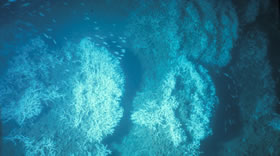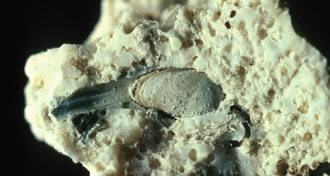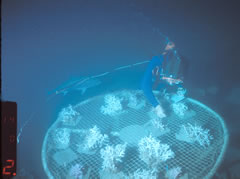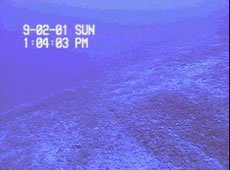May 1, 03
Like Redwoods Under
the Sea
by Taylor Sisk
 Twenty miles, give or take off the coast of Florida, stretching
from Daytona Beach down to Ft. Pierce, hugging tight to the continental
shelf, deep-water coral reefs called Oculina varicosa grow on the
ocean floor, 200 to 300 feet beneath the water’s surface.
The deep-water Oculina reefs are quite unique, perhaps the only
of their variety in the world. As such, in 1984, the National Oceanic
and Atmospheric Administration’s National Marine Fisheries
Service designated a 92-square-mile portion of these reefs as a
Marine Protected Area (MPA), meaning that no fish trawling is allowed
within its boundaries. In 1994, the MPA was closed to all manner
of bottom fishing; in 2000, the area was expanded to 300 square
miles.
Twenty miles, give or take off the coast of Florida, stretching
from Daytona Beach down to Ft. Pierce, hugging tight to the continental
shelf, deep-water coral reefs called Oculina varicosa grow on the
ocean floor, 200 to 300 feet beneath the water’s surface.
The deep-water Oculina reefs are quite unique, perhaps the only
of their variety in the world. As such, in 1984, the National Oceanic
and Atmospheric Administration’s National Marine Fisheries
Service designated a 92-square-mile portion of these reefs as a
Marine Protected Area (MPA), meaning that no fish trawling is allowed
within its boundaries. In 1994, the MPA was closed to all manner
of bottom fishing; in 2000, the area was expanded to 300 square
miles.
(above: healthy Oculina)
Walk into a bait shop anywhere along the coast of Florida, though,
and odds are the fishing map you pull from the rack will have no
indication of the above. No mention of fishing restrictions, no
acknowledgement of an MPA. And that’s a problem.
It certainly doesn’t make John Reed’s job any easier.
Reed is a marine scientist with the Harbor Branch Oceanographic
Institution in Ft. Pierce. He’s presently co-principal investigator
on an eight-day expedition led by the NOAA Undersea Research Program
to learn more about the Oculina reefs. Reed has been studying the
Oculina for 25 years; it’s been the primary focus of his entire
career. It was he, in fact, who nominated the Oculina as a protected
area.
“When I was first out of graduate school,” says Reed,
“I was hired at Harbor Branch, and this was  just
after they’d discovered the deep-water Oculina reefs using
the Johnson-Sea-Link submersible. They had just come across one
of these 60 to 100 foot high reefs covered with coral. “My
first study, in 1976, was to see what lived in the coral, what used
it for habitat. And over the next 10 years I did a number of studies.
I began to study the invertebrates, and what I found out was that
a small coral with a head the size of a basketball could hold up
to over 2,000 individual animals and hundreds of species, from worms
to crabs to shrimp to fish – it was an incredibly bio-diverse
environment that we had never known about before.
just
after they’d discovered the deep-water Oculina reefs using
the Johnson-Sea-Link submersible. They had just come across one
of these 60 to 100 foot high reefs covered with coral. “My
first study, in 1976, was to see what lived in the coral, what used
it for habitat. And over the next 10 years I did a number of studies.
I began to study the invertebrates, and what I found out was that
a small coral with a head the size of a basketball could hold up
to over 2,000 individual animals and hundreds of species, from worms
to crabs to shrimp to fish – it was an incredibly bio-diverse
environment that we had never known about before.
(at right: a bivalve imbedded in
Oculina)
“By 1980, we realized that this was a totally unique habitat
found nowhere else in the continental United States. And possibly
nowhere else in the world. “At the same time, I began to look
at how fast  the
coral grows. So my next study was to see how old their heads were.
We were seeing coral heads the size of a Volkswagen Beetle. I did
a study over two years and found that they actually grow very slowly,
about a half an inch a year. So a large head could easily be 100,
200 years old. Then I did a core – which is just a sample
within one of these reefs – to get some of the reef structure,
and we did radio- carbon dating of the dead coral that came from
the inside of the reef.”
the
coral grows. So my next study was to see how old their heads were.
We were seeing coral heads the size of a Volkswagen Beetle. I did
a study over two years and found that they actually grow very slowly,
about a half an inch a year. So a large head could easily be 100,
200 years old. Then I did a core – which is just a sample
within one of these reefs – to get some of the reef structure,
and we did radio- carbon dating of the dead coral that came from
the inside of the reef.”
(at left: a coral growth table)
What Reed and his colleagues learned was that the particular coral
they had examined was 8,000 years old, meaning that the entire reef
structure had been around 10,000 to 12,000 years. “We also
came to realize,” Reed continues, “how fragile the coral
was: the branches themselves are the diameter of a pencil, and the
reefs form into big bushes. So imagine how any heavy weight, like
fishing gear, dragging through it, could very easily crush it.

“At that time, in the early ‘80s, there was indication
that boats were coming down from the Georgia coast and fishing with
roller trawls; they could fish on the bottom of high-relief areas
– they had wheels on chains so that they could easily roll
over the bottom of the ocean.”
These rare coral reefs, home to hundreds of species, including commercially
important fish, were being destroyed. It would take hundreds of
years to restore them, if they could be restored at all. Thus the
need for protection. (at right: trawl
tracks through a destroyed Oculina reef)
“My main concern is that while on paper this has been a protected
area since 1984, it’s still being heavily fished,” both
by poachers and the unaware. “Tremendous damage can be done
by an errant shrimp trawler going across one of these pristine reefs.
One pass can destroy a great many reefs.”
Protected areas mean little if not for, first and foremost, public
awareness. Maps indicating the boundaries of the MPA would certainly
help. As will a further understanding of the importance of these
national natural treasures.
“There is public outcry about making too many protected areas,”
says Reed. “But the size of the MPA is really a miniscule
percentage of the overall area. “They’re like the redwood
forests. These reefs are thousands of years old. And there are no
others like them in the world.”
This report was prepared by Taylor Sisk, a journalist,
marketing communications consultant and film & video producer.
He has written for The Independent, San Francisco Weekly, Southern
Exposure and the Oxford Dictionary of the Social Sciences; was a
writer/researcher on the History Channel: The Ellis Island Experience
(CD-ROM; South Peak Interactive); and was director/producer for
the Drug Policy Alliance’s California Help Stop AIDS TV ad
campaign. He served as executive producer of Takeover: The Trials
of Eddie Hatcher (Golden Gate Award, San Francisco International
Film Festival; Jurors’ Selection, NC Film and Video Festival)
and is presently at work on The Berrigan Brothers: America is Hard
to Find. He is the proprietor of No Exit Productions, based in Kure
Beach, North Carolina.
Sisk is aboard the Liberty Star as a contracted writer and communications
consultant for the NOAA Undersea Research Program.







